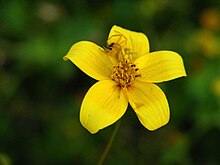Misumenoides
This article does not cite any sources. (August 2020) |
| Misumenoides | |
|---|---|

| |
| Possibly , on the Bidens ferulifolia | |
| Scientific classification | |
| Kingdom: | Animalia |
| Phylum: | Arthropoda |
| Subphylum: | Chelicerata |
| Class: | Arachnida |
| Order: | Araneae |
| Infraorder: | Araneomorphae |
| Family: | Thomisidae |
| Genus: | Misumenoides F. O. P-Cambridge, 1900 |

Misumenoides is a genus of spiders in the family Thomisidae. Spiders in this family are commonly called "crab" or "flower" spiders.
Species[]
- (O. P.-Cambridge, 1891) – Mexico, Guatemala
- F. O. P.-Cambridge, 1900 – Guatemala
- (O. P.-Cambridge, 1891) – Guatemala, Panama
- Mello-Leitão, 1941 – Argentina
- (Holmberg, 1881) – Argentina
- Mello-Leitão, 1929 – Brazil
- (Keyserling, 1880) – Colombia
- Mello-Leitão, 1943 – Chile
- Caporiacco, 1955 – Venezuela
- (O. P.-Cambridge, 1891) – Guatemala
- Mello-Leitão, 1938 – Argentina
- Misumenoides formosipes (Walckenaer, 1837) – Canada, United States
- Mello-Leitão, 1929 – Brazil
- Mello-Leitão, 1944 – Argentina
- Soares, 1944 – Brazil
- (Keyserling, 1880) – Mexico to Colombia
- Roewer, 1951 – Chile
- Mello-Leitão, 1929 – Brazil
- (Keyserling, 1880) – Brazil
- (Keyserling, 1880) – Mexico to Colombia
- Mello-Leitão, 1929 – Brazil, Guyana
- Mello-Leitão, 1944 – Argentina
- Jiménez, 1992 – Mexico
- Mello-Leitão, 1949 – Brazil
- Caporiacco, 1947 – Guyana
- Mello-Leitão, 1947 – Brazil
- (O. P.-Cambridge, 1891) – Guatemala, Panama
- (Keyserling, 1881) – Brazil
- (O. P.-Cambridge, 1891) – Panama, Brazil
- Mello-Leitão, 1941 – Argentina
- (O. P.-Cambridge, 1890) – Guatemala
- Mello-Leitão, 1929 – Brazil
The female Misumenoides formosipes, while similar to Misumena vatia, is not as large, and can be distinguished by the inverted 'V' marking on its back (with the point of the V closer to the cephalothorax) and the 'mask' over its eyes. In most respects this spider behaves like the goldenrod spider, also commonly hunting in goldenrod sprays in the fall. It tends to take smaller prey, however, avoiding the bumblebees and large butterflies in favor of honeybees, large flies and small butterflies such as skippers. Male M. formosipes are quite distinctive, being much smaller than females and having a greenish cephalothorax, yellow-orange abdomen, and long, red to reddish-black front legs. They are found on a wide variety of plants as they wander in search of females in late summer and early fall.
References[]
External links[]
- Thomisidae
- Araneomorphae genera
- Spiders of South America
- Spiders of North America
- Thomisidae stubs